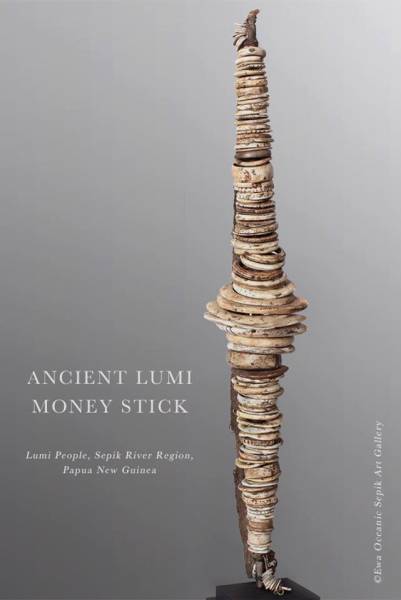Ancient Lumi money sticks – exhibition

© Ewa Gallery
English
The money stick, highly regarded by the Lumi people is used to buy land & brides. The length of the money stick and number of shells, represents the wealth & prestige of its owner. The gallery presents a collection of Lumi money stick unseen before.
Shell money is a medium of exchange similar to money that was once commonly used in many parts of the world. Shell money usually consisted either of whole sea shells or pieces of them, which were often worked into beads or were otherwise artificially shaped. The use of shells in trade began as direct commodity exchange, the shells having value as body ornamentation. The distinction between beads as commodities and beads as money has been the subject of debate among economic anthropologists.[1]
Some form of shell money appears to have been found on almost every continent: America, Asia, Africa and Melanesia.
n the islands north of New Guinea the shells were broken into flakes. Holes were bored through these flakes, which were then valued by the length of a threaded set on a string, as measured using the finger joints. Two shells are used by these Pacific islanders, one a cowry found on the New Guinea coast, and the other the common pearl shell, broken into flakes.
In the South Pacific Islands the species Oliva carneola was commonly used to create shell money. As late as 1882, local trade in the Solomon Islands was carried on by means of a coinage of shell beads, small shells laboriously ground down to the required size by the women. No more than were actually needed were made, and as the process was difficult, the value of the coinage was satisfactorily maintained.
On the Papua New Guinea island of East New Britain shell currency is still considered legal currency and can be exchanged for Kina.
Shell money is a medium of exchange similar to money that was once commonly used in many parts of the world. Shell money usually consisted either of whole sea shells or pieces of them, which were often worked into beads or were otherwise artificially shaped. The use of shells in trade began as direct commodity exchange, the shells having value as body ornamentation. The distinction between beads as commodities and beads as money has been the subject of debate among economic anthropologists.[1]
Some form of shell money appears to have been found on almost every continent: America, Asia, Africa and Melanesia.
n the islands north of New Guinea the shells were broken into flakes. Holes were bored through these flakes, which were then valued by the length of a threaded set on a string, as measured using the finger joints. Two shells are used by these Pacific islanders, one a cowry found on the New Guinea coast, and the other the common pearl shell, broken into flakes.
In the South Pacific Islands the species Oliva carneola was commonly used to create shell money. As late as 1882, local trade in the Solomon Islands was carried on by means of a coinage of shell beads, small shells laboriously ground down to the required size by the women. No more than were actually needed were made, and as the process was difficult, the value of the coinage was satisfactorily maintained.
On the Papua New Guinea island of East New Britain shell currency is still considered legal currency and can be exchanged for Kina.
Partager :



